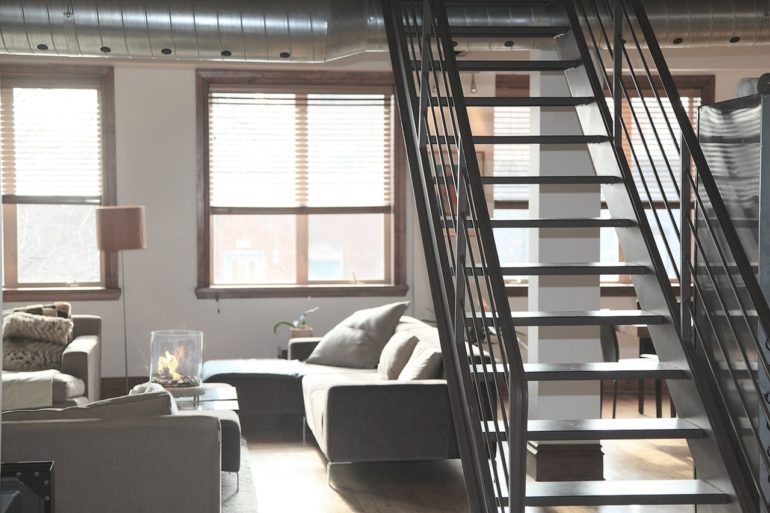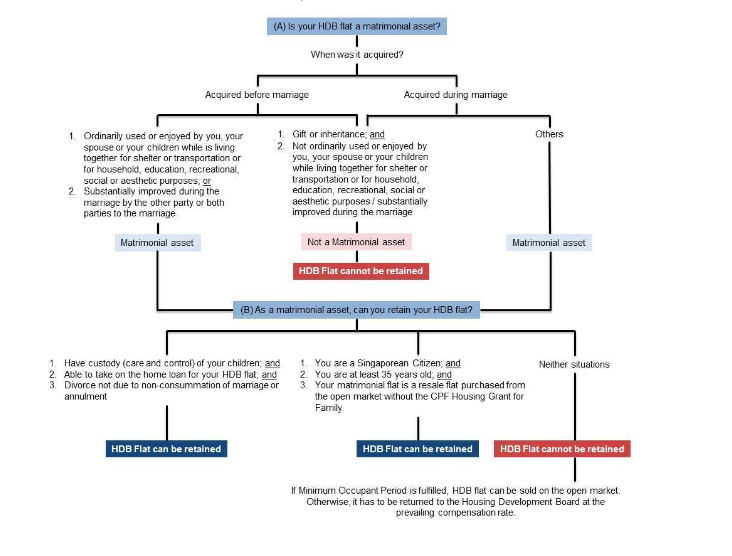The Department of Statistics Singapore has noted that divorce rates in 2016 were at a 10-year high. If you are currently undergoing divorce proceedings, we understand that it is a difficult process. One of your biggest concerns might be what would happen to your HDB flat after your divorce, given that it is likely to be one of your largest assets. In this guide, we are going to set out the various possible scenarios and explore whether you would be entitled to retain your flat in those scenarios. For an overview, we will illustrate this entire process with the use of a flow chart.
(A) Your HDB flat is most likely a matrimonial asset
According to section 112(10) of the Women’s Charter, matrimonial assets include assets acquired before or during marriage by one or both parties. If the asset is acquired before the marriage, it must fulfil the following two criteria:
- It must be ordinarily used or enjoyed by both parties or one or more of their children while the parties are living together for shelter or transportation or for household, education, recreational, social or aesthetic purposes; or
- It has been substantially improved during the marriage by the other party or both parties to the marriage.
As a result, if your HDB is a gift or an inheritance and has not fulfilled either of the two conditions above, it would not be categorised as a matrimonial asset.
Once ascertained as a matrimonial asset, the next issue is whether you will be able to retain the HDB flat instead of selling it.
(B) You will be able to keep your HDB flat in the following situations after a divorce:
Divorced with children
If you have care and control of your children, you will be able to keep the flat assuming you qualify financially to take on the home loan for your HDB flat. Another requirement is that the divorce cannot be a result of non-consummation of marriage or annulment.
Example:
Delia is a Singaporean and has been married to Tom for 10 months. The HDB flat was jointly acquired during their marriage. At the time of marriage, she was pregnant by someone other than her fiancé. After Tom found out, he has chosen to annul the marriage as it is still within the first 3 years of marriage. She has care and control of the child. Can she retain the HDB flat?
Delia cannot retain the HDB flat as the divorce is a result of annulment. The flat would have to be returned to HDB at the prevailing compensation as the five-year Minimum Operation Period (MOP) has not been fulfilled.
Divorced with no children
You may keep the flat under the Single Singapore Citizen (SSC) Scheme if:
- You are a Singaporean Citizen;
- You are at least 35 years old; and
- Your matrimonial flat is a resale flat purchased from the open market without the CPF Housing Grant for Family
For matrimonial flats bought directly from HDB and resale flats bought with the CPF Housing Grant for Family, the five-year MOP must be satisfied before you can keep the flat under the SSC Scheme. Alternatively, you can include another person to keep the flat with, but this is subject to the prevailing eligibility conditions and schemes.
Should neither party meet the requirements of the above-mentioned situations, you will have to sell it.
Example:
Joel is an Indonesian who holds a Long-term Visit Pass. He is 32 years old. He married a Singaporean 6 years ago and they jointly acquired a HDB flat during their marriage. They have no children. They are now divorced. Can he retain the flat?
Joel cannot retain the HDB flat. As he is not a Singapore citizen and is only 32 years old, he cannot retain the flat under the SSC scheme. However, as the flat was jointly acquired during marriage, it is matrimonial property and he should be entitled to a share of the sale proceeds of the flat when sold in the open market.
(C) You will not be able to keep your HDB flat if you do not fall within either of the above two scenarios:
If the MOP is completed, you can sell the flat in the open market. If not, you will have to return the flat to the HDB at the prevailing compensation.
The sale proceeds will first be used to pay off any outstanding mortgage loan and reimburse your CPF with the amounts used for the purchase of your HDB flat with accrued interest. The remaining balance will then be divided between you and your ex-spouse according to the court order for the divorce.
How the remaining balance of sale proceeds from your HDB flat would be divided
In Singapore, the courts have adopted a multi-factorial approach in considering the non-exhaustive factors stated below to achieve a just and equitable division:
- Direct contributions
- For example, the amount of money each party contributed to acquire orimprove the HDB flat
- Indirect contributions
- For example, playing a caregiving role in the family
- Needs of the children
For dual-income marriages (marriages where both spouses are working), this multi-factorial approach is complemented by the structured approach in ANJ v ANK to divide the assets in a just and equitable manner. First, the parties’ direct financial contributions towards the acquisition or improvement of the HDB flat will be determined and represented as a ratio. A second ratio will then be determined from the parties’ indirect contributions. Third, the two ratios will be averaged out to determine a final ratio. The ratios will be averaged out based on the weightage given to each type of contribution depending on the circumstances of each case.
In ANJ v ANK, both spouses were working. The courts held that there was an equal division of the matrimonial assets. To derive this figure, the courts first determined that the Husband’s and the Wife’s direct contribution to the pool of matrimonial assets was 60% and 40% respectively. The courts then found that the Husband’s and the Wife’s indirect contribution was 40% and 60% respectively due to the Wife’s role as the primary caregiver of the children and the primary homemaker. Averaging these two ratios thus led to the final percentage contributions of 50:50.
For long single-income marriages (being marriages where one spouse is the sole breadwinner while the other is a homemaker), however, the Court of Appeal in TNL v TNK held that the structured approach should not be applied as it unduly favours the spouse who is the sole breadwinner. This is because he/she would be accorded nearly all of the direct financial contributions in the first step, thus be guaranteed an additional percentage overall even if his/her indirect non-financial contributions were minimal. In TNL v TNK, the husband was the sole breadwinner of the family while the wife looked after the household. The marriage lasted for a duration of approximately 38 years. Rather than apply the approach discussed above in ANJ v ANK, the courts held that there should be an equal division of 50:50.
This is in contrast with cases of short single-income and childless marriages, where parties typically walk away with more or less what they brought into the marriage.
It should be noted that there is no hard and fast rule to this division. The courts essentially strive to divide the assets in the most equitable way possible.
Have a question on division of matrimonial assets?
If you have any questions regarding the division of matrimonial assets, you can get a Quick Consult with Nadia Moynihan or with other lawyers. With Quick Consult, from a transparent, flat fee from $49, a lawyer will call you on the phone to give you legal advice.
This article is written by Nadia Moynihan from August Law Corporation and Joanne Liew from the Asian Law Students’ Association.
This article does not constitute legal advice or a legal opinion on any matter discussed and, accordingly, it should not be relied upon. It should not be regarded as a comprehensive statement of the law and practice in this area. If you require any advice or information, please speak to practicing lawyer in your jurisdiction. No individual who is a member, partner, shareholder or consultant of, in or to any constituent part of Interstellar Group Pte. Ltd. accepts or assumes responsibility, or has any liability, to any person in respect of this article.


